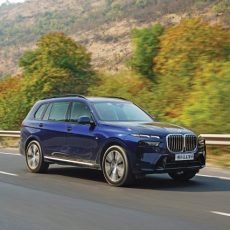It was almost Utopian. Patches of the nimbus scattered in the azure sky, cool breeze blowing, happy kids playing, ladies out on their evening walk as I drove into the cheerful housing complex in the Prius, the Green Peace warriors clean and green dream machine. Instantly, the car became the centre of attraction and made heads turn; some in reverence, others in curiosity.
By the time I got off the car to manually fold the outer rear view mirrors, there were about a dozen kids thronging around it. Peeping inside the cockpit of the Toyota, one of the tiny ones asked me in awe if it was a spaceship and I couldn’t help but answer, “Almost.” The Toyota Prius is the world’s largest selling hybrid and the only sedan available in India that runs on petrol and battery power. It already has a huge fan following internationally, which includes several Hollywood celebrities, sports personalities and everyone else who wants to express their concern for the environment, provided they can afford it. But mind you, this hybrid is not just aimed at saviours of the earth, but also at regular mainstream buyers who are looking for some thing interesting.

The third generation of the Prius was introduced in our country earlier this year at the Auto Expo 2010. Toyota’s Chief Designer, Wahei Hirai had a task to make the car skim through air. Every crease on the Prius plays an important role to accentuate the aerodynamics and reduce air turbulence. The car looks the way it does not by choice but due to necessity. Everything from the bump on the hood, the ridged roof, to the Kammback rear end design have a very important role to play. There is an underbody rear fin that helps to stabilize the vehicle at higher speeds. Even the tyres have lower rolling resistance to reduce rolling resistance. There has been a lot of hard work that the firm’s R&D has put in to achieve the amazing co-efficient of drag to 0.25, making it one of the most aerodynamic sedans sold in the world. The name Prius has been derived form the Latin word, ‘prior’ or ‘ahead.’ I think what Japanese auto majors might have meant by it was that this will be the predecessor of cars to come. Quite rightly so, as the hybrid is loaded with cutting edge technology and a practical design. As you step into the cabin, you notice that there is nothing luxurious about it but true to the car’s theme, it has a very smart design. There’s no pretense, so don’t expect fake leather or artificial wood trim. Instead, Toyota uses a new range of plant based eco-plastics made from the cellulose in wood or grass instead of petroleum.
The dash looks radical with the instrument console and the information display right in the centre. Below it is the music system followed by the air-con controls and the pinched centre vents. Underneath this are three buttons to select the driving mode – Eco, Power and EV (Electric Vehicle) and next to the extreme right are buttons for the heads-up display. The dash merges in the high centre console and gives the cabin a very hi-tech feel. The cute blue gear selector with Push-To-Select feature reminds me of a BMW, the foot operated parking brake is Mercedes-like and the flat based steering wheel seems Audi inspired. You get feather touch controls on the steering which is a nice feel. There are more cubbyholes and storage areas than you need and overall, the cabin feels roomy with enough headroom and elbow space. The seats are pretty comfortable with electrically adjustable lumbar support, though they have to be adjusted manually. You can also opt for seat heaters, but at a cost. The rear legroom is decent, after all it is based on the Corolla, and the sloping roof line does not interfere with the headroom too much.




